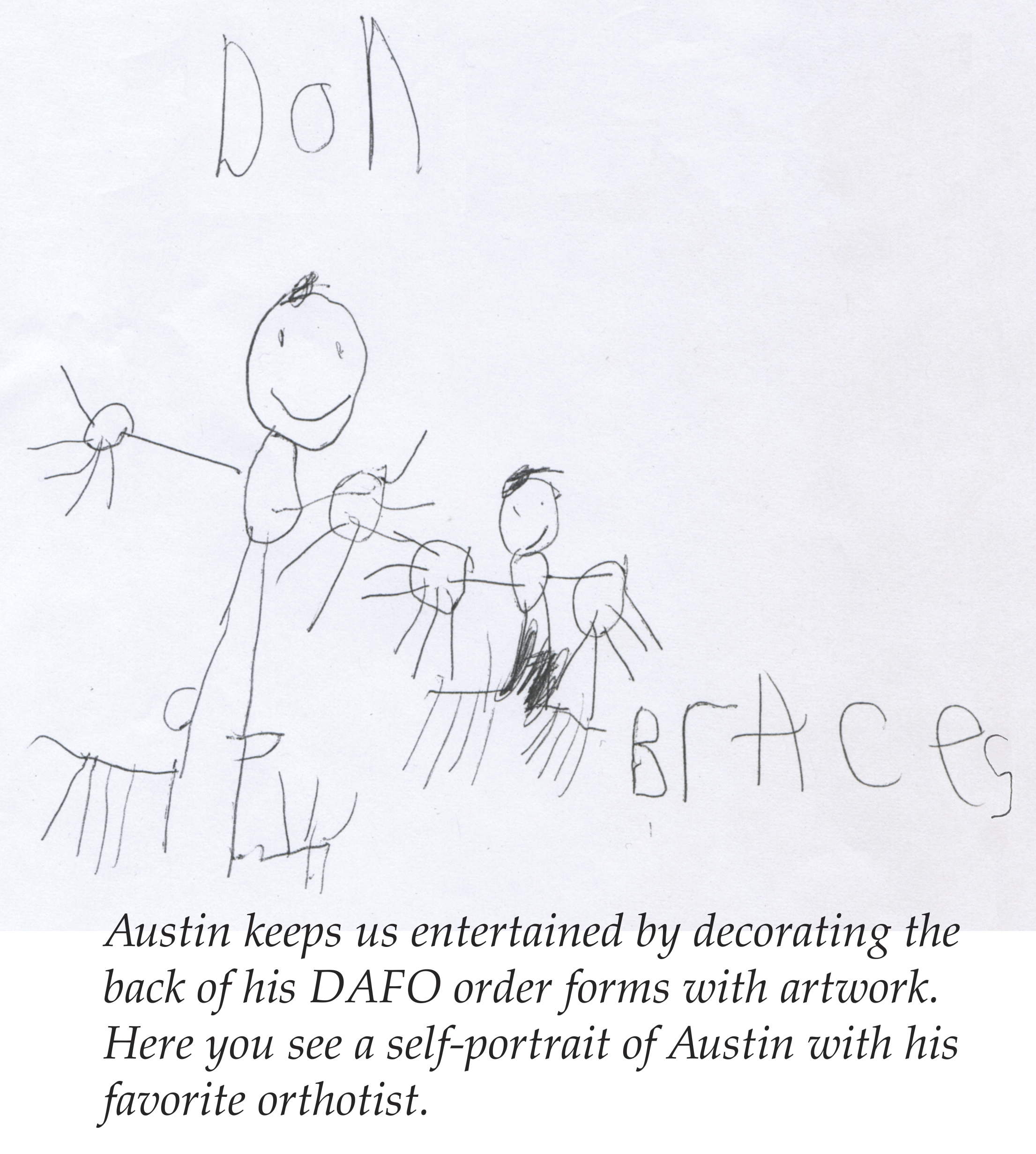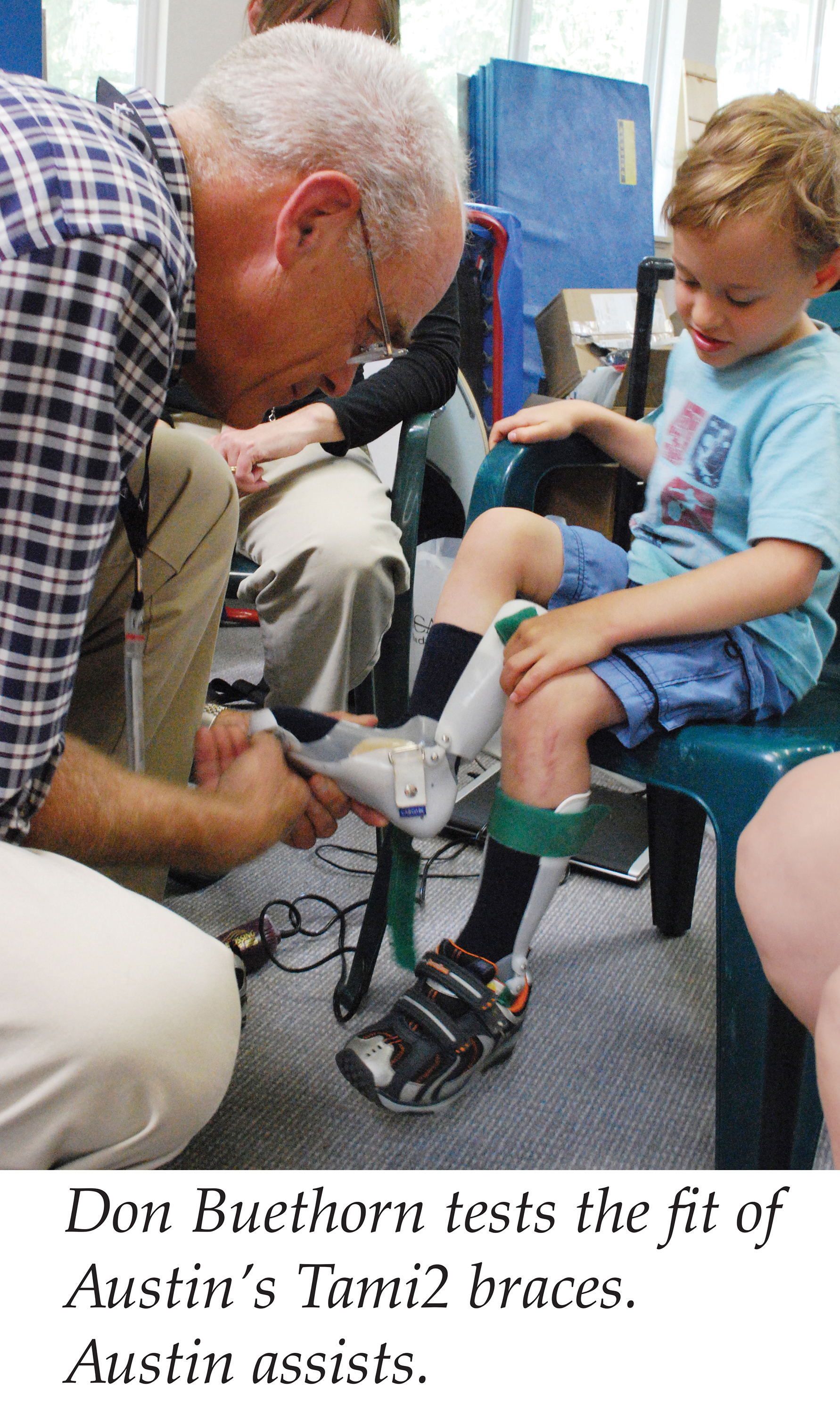Multiple Presentations and Therapy Goals
— Vicki Schwartz, PT and Loretta Sheldon, ROA, CFo

Meet Austin. A sharp-dressed little man with an impressive vocabulary and a vivacious personality, this six-year-old is one of our favorite patients. Born premature, at 27-1/2 weeks Austin suffered a grade III intraventricular hemorrhage three days after birth which required placement of a ventroperitoneal shunt and, later, a diagnosis of spastic diplegia. Never without his trademark grin, Austin is a highly-motivated kiddo with an unfailing determination to succeed.remature
Austin’s case is a prime example of how external circumstances can play a critical role in the brace selection process.
Global factors for Austin
External circumstances (or global factors, as we call them) are elements of clinical work that we all consider, in one form or another. They include family and developmental expectations, therapist’s treatment goals, family cultural values, patient attitude.
This patient has what could be called an all-star lineup when it comes to his clinical team. Upon discharge from the hospital 12 weeks after his birth, Austin received periodic occupathional therapy visits from Judy Simmons, OT, for the first year. At nine months he started receiving physical therapy from Betsy Kachmarik, PT, and later with Mechtild Rast, OT. Austin’s orthotist, Don Buethorn, has been working closely with another highly respected physical therapist, Vicki Schwartz, since January 2007 in preparation for Austin’s selective dorsal rhizotomy in July 2007.

Austin received intensive physical therapy following his surgery, four times a week for six months, then three times a week for another year before decreasing to his current schedule of PT once a week and once-weekly hippotherapy with Steve McKenzie. Austin’s physical therapy sessions frequently focus on improving his gait. His therapies are also supplemented by weekly participation in Aikido and swimming classes and seasonal recreational activities like soccer, cross country skiing, and T-ball with his friends. Austin’s mother, also a physical therapist, and his dad supplement his therapy sessions with at-home exercises.
Perhaps most important, the patient himself is highly motivated and has an invaluable work ethic. Every time we see him, he has made significant progress. His compliance is excellent. Austin is very expressive and can provide precise feedback about how his braces feel.
Age 3: Initial presentation
When we first saw Austin about three years ago, he was walking independently with a walker. He presented with excessive
pronation and pronounced knee hyperextension. From the initial assessment we could see that Austin’s hyperextension was a result of his high-tone ankle plantarflexion. (Due to his excessive plantarflexion, Austin hyperextended his knees during gait to give himself a more stable position that required less muscle strength to maintain.) Austin’s hindfeet were correctable to subtalar neutral, though without good external support he would collapse into very strong pronation. His feet were noticeably thin and boney. In order to deliver something comfortable enough for him to use, careful positioning and brace planning were key.
 For his initial set of braces, Austin’s physical therapist wanted something that would improve his foot position but would interfere as little as possible as they achieved their therapy goals. Austin initially used the added support of a walker along with his new braces to assist with ambulation.
For his initial set of braces, Austin’s physical therapist wanted something that would improve his foot position but would interfere as little as possible as they achieved their therapy goals. Austin initially used the added support of a walker along with his new braces to assist with ambulation.
We initially chose the custom DAFO® 4 SMO for Austin in order to provide thin, flexible wrap-around support of his pronated foot position while allowing maximum freedom in the sagittal plane (dorsiflexion/plantarflexion—DF/PF).
It is important to note that Austin’s ideal level of bracing support may be lower than that of a patient with an identical presentation. Austin’s unique clinical team, high level of compliance, and work ethic strongly influenced our decision to choose the DAFO 4.
Through the use of the custom DAFO 4, we were able to successfully address the frontal plane by providing Austin with adequate pronation control. His therapist wanted to work with freedom of movement in the sagittal plane as she helped him on strength building and assisted ambulation. Following his dorsal rhizotomy surgery, Austin progressed, replacing the walker with two walking sticks.
Age 6: Orthosis plan refined based on progress
As Austin grew and gained strength and skill through physical therapy, he was able to progress to walking and running without his walking sticks. When assessing his gait in the DAFO 4 braces alone, we could see that his hyperextension at the knees was more pronounced as he attempted to add the stability he needed. Our refined goals would include providing flexible, wrap-around support of Austin’s pronated foot position and adding in some dynamic resistance to hyperextension at the knee. We wanted to provide just enough support and stabilization to set him up for success while encouraging voluntary control of knee hyperextension. Access to PF during gait is useful at heel strike and offers a smoother transition to the foot-flat phase. In most cases, we want to avoid taking any useful movement away from the patient, if circumstances allow.
 As Austin outgrew his DAFO 4s and we re-assessed his needs, we selected another level of bracing. His newly independent ambulation, as well as his unique external circumstances, were critical elements of the new bracing plan. Otherwise, we may have had to draw more support from the brace itself.
As Austin outgrew his DAFO 4s and we re-assessed his needs, we selected another level of bracing. His newly independent ambulation, as well as his unique external circumstances, were critical elements of the new bracing plan. Otherwise, we may have had to draw more support from the brace itself.
Therapy goals, a motivated patient, and dynamic, wrap-around support make a wonderful substitute for rigid bracing. At Cascade Dafo, our goal is to always offer the least amount of support needed to get the job done. It is essential to understand how much or how little help will be added outside the control that the brace itself can offer.
We chose the free ankle version of the DAFO Tami2 for Austin, to support his forefoot position in supination when the heel is aligned to get better heel strike. Again, we heavily weighed external circumstances in making this brace selection. Without this patient’s ideal situation, we may have chosen a brace that fully blocks PF rather than one that simply resists that motion. A Tami2 with a PF block trimline or a DAFO 2 hinged AFO are two options we could have considered.
Seasoned DAFO customers may be familiar with the Tami2. Launched in 2007, the Tami2 is our two-piece AFO with Tamarack hinges. It can be ordered with either a free ankle or a PF block trimline. The inner boot provides flexible, wrap-around pronation control in either design. The proximal section wraps around the posterior, medial, and lateral surfaces of the lower leg. The foot and leg portions of the brace work together to provide increased frontal plane alignment (as compared to an SMO design) by allowing the leg to help hold the foot position. With the PF block option, the brace also blocks movement in the range of degrees from (a) where the DF angle of the brace is set, to (b) everything representing more PF than that. The Tamarack joint also offers choices in stiffness (higher durometers equal stiffer action). The straight (non-dorsiflexed) Tamarack joints do not strongly impact DF/PF action. The dorsi-assist joints add a hint of PF resistance and encourage DF during swing phase because they return to a preset DF position each time the foot is picked up off the ground.
The Tami2 is now included in the new DAFO guide to brace section. This new tool is a major revision of Cascade Product Selection Guide.
Video version and Austin’s progress
For a look at the initial fitting of Austin’s Tami2 braces, we invite you to visit
www.cascadedafo.com/videos. As you’ll see, the first look at Austin walking in his braces appears somewhat disappointing. While the braces do an excellent job of helping to control Austin’s excessive pronation, his knee hyperextension is not significantly impacted at the initial fitting.
However, on a clinic visit several weeks after Austin’s initial fitting, we were very encouraged by his results. Through a combination of time spent adjusting to his braces, therapy sessions, and hard work, he is having great success in his Tami2s. They provide what for Austin is the lowest level of support that gets the job done, allowing him to move faster and with less fatigue while continuing to work on voluntary control and strength.
As we follow up with him further, watch our website for more videos of Austin’s continued progress.

 Vicki Schwartz, PT, has been an owner of Cascade Children’s Therapy since 1989. She received a BS from the University of Vermont in physical therapy in 1976 and has worked in a variety of pediatric settings since then. She is NDT certified (1987) and certified in Sensory Integration Theory and Treatment (1983).
Vicki Schwartz, PT, has been an owner of Cascade Children’s Therapy since 1989. She received a BS from the University of Vermont in physical therapy in 1976 and has worked in a variety of pediatric settings since then. She is NDT certified (1987) and certified in Sensory Integration Theory and Treatment (1983).
 Loretta Sheldon, ROA, CFo, is an ABC Registered Orthotic Assistant, a Certified Fitter of Orthoses, and a member of Cascade’s management team. She has been with Cascade since 1998.
Loretta Sheldon, ROA, CFo, is an ABC Registered Orthotic Assistant, a Certified Fitter of Orthoses, and a member of Cascade’s management team. She has been with Cascade since 1998.